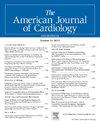血红蛋白清道夫受体表达增强与二尖瓣主动脉瓣狭窄相关
IF 2.1
3区 医学
Q2 CARDIAC & CARDIOVASCULAR SYSTEMS
引用次数: 0
摘要
最近的研究表明,小叶内出血在二尖瓣主动脉瓣(BAV)中比在三尖瓣(TAV)中更常见,这可能是导致BAV主动脉瓣狭窄(AS)进展更快的原因。血红蛋白(Hb)诱导的氧化损伤通过触珠蛋白(Hp)发生,触珠蛋白不可逆地结合红细胞外的Hb,形成Hp-Hb复合物。在瓣膜小叶中,这种复合物仅由CD163受体介导的巨噬细胞清除。氧化应激也与AS的进展有关。在这项研究中,我们检测了伴有TAV (n=35)或BAV (n=34)的AS患者的主动脉瓣内出血、氧化应激和CD163表达之间的关系。术中采集瓣膜标本。免疫组化使用针对巨噬细胞、糖蛋白A(红细胞膜标志物)、CD31、CD163和脂质过氧化标志物4-羟基-2-壬烯醛(4-HNE)的抗体。定量分析显示,BAV标本的巨噬细胞浸润、糖蛋白A、4-HNE、微血管密度和cd163阳性巨噬细胞均显著高于TAV(均P本文章由计算机程序翻译,如有差异,请以英文原文为准。
Enhanced Expression of Hemoglobin Scavenger Receptor is Associated With Aortic Valve Stenosis in Patients With Bicuspid Aortic Valve
Recent studies suggest that intraleaflet hemorrhage is more common in bicuspid aortic valves (BAV) than in tricuspid valves (TAV), possibly contributing to the faster progression of aortic stenosis (AS) in BAV. Hemoglobin (Hb)-induced oxidative damage occurs via haptoglobin (Hp), which irreversibly binds extracorpuscular Hb, forming an Hp-Hb complex. In valve leaflets, this complex is cleared only by macrophages mediated by the CD163 receptor. Oxidative stress has also been implicated in AS progression. In this study, we examined the relationship between intraleaflet hemorrhage, oxidative stress, and CD163 expression in aortic valves from AS patients with TAV (n = 35) or BAV (n = 34). Valve specimens were collected during surgery. Immunohistochemistry was performed using antibodies against macrophages, glycophorin A (an erythrocyte membrane marker), CD31, CD163, and 4-hydroxy-2-nonenal (4-HNE), a marker of lipid peroxidation. Quantitative analysis showed that BAV specimens had significantly greater macrophage infiltration, glycophorin A, 4-HNE, microvessel density, and CD163-positive macrophages than TAV (all p <0.05). CD163-positive macrophage scores positively correlated with 4-HNE and glycophorin A areas (both p <0.0005). These results indicate a strong association between CD163 expression and both intraleaflet hemorrhage and lipid peroxidation. In conclusion, intraleaflet hemorrhage–associated oxidative stress may promote rapid AS progression in BAV patients.
求助全文
通过发布文献求助,成功后即可免费获取论文全文。
去求助
来源期刊

American Journal of Cardiology
医学-心血管系统
CiteScore
4.00
自引率
3.60%
发文量
698
审稿时长
33 days
期刊介绍:
Published 24 times a year, The American Journal of Cardiology® is an independent journal designed for cardiovascular disease specialists and internists with a subspecialty in cardiology throughout the world. AJC is an independent, scientific, peer-reviewed journal of original articles that focus on the practical, clinical approach to the diagnosis and treatment of cardiovascular disease. AJC has one of the fastest acceptance to publication times in Cardiology. Features report on systemic hypertension, methodology, drugs, pacing, arrhythmia, preventive cardiology, congestive heart failure, valvular heart disease, congenital heart disease, and cardiomyopathy. Also included are editorials, readers'' comments, and symposia.
 求助内容:
求助内容: 应助结果提醒方式:
应助结果提醒方式:


